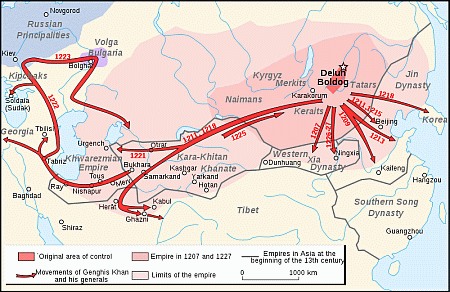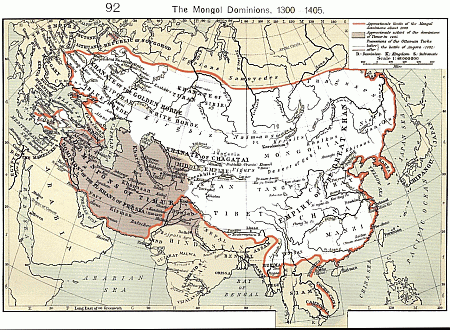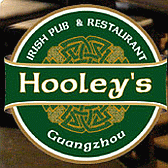|
|
| Chinese
History |
Imperial
China - Yuan
|
|
|
Yuan (1271 –
1368)
This represents the Mongol invasion(s) of China, which
went as far as the shores of Japan, included the domination
and subjugation of Tibet, most of eastern Russia, a
lot of Europe.
Genghis Khan is still a name that is remembered today,
and he controlled or gave rise to: The largest Empire
ever witnessed
The names you may know from history books are Genghis
Khan, and his grandson Kublai Khan. What you may not
know is that the Mongols were divided, as some like
Kublai Khan wanted to adopt Chinese culture, whilst
others did not. Genghis just wanted to rule the world,
and he virtually did!

The Mongols are always rendered as ruthless aggressors,
but let's study this in more detail. It is true to say
they were very well disciplined and formidable foes,
feared all over the known world by their enemies. What
is overlooked is that they were also traders and merchants.
To their friends and allies they brought security and
prosperity. To ordinary people who tilled the land they
brought fair and just living
From the map above you will see that in their early
years they ruled an area that spread from Korea to Georgia,
and included Afghanistan and Kashmir (Simplified). They
controlled most of Northern China, and especially prized
the fertile plains previously held by the Western Xia.
Temujin was a successful ruler or Khan, with shrewd
military brain coupled with the ability to spot talent
and gather the brightest people to him. He became Universal
Ruler (Of the World) or Genghis Khan in 1202 at the
age of 46. He greatly improved military organisation
and created a powerful homogenous group of Mongols.
With this unity came strength, and he built upon this
by instigating a fair legal system, something that had
previously brought disharmony within Mongol Tribes.
He outlawed stealing women and animals, selling brides
into marriages. Lost animals were now to be returned
to the rightful owner and not kept by the finder. All
these were made capital offences. This was administered
by a light civil service, backed by the written language
he had created some years earlier
He needed to secure his borders, so made alliance with
the Uyghurs (Kara-Khitin Khanate) who controlled the
Western Silk Road. This was sealed by marriage of his
daughter to the Uyghur Khan; who brought a caravan of
gold, silk, and much treasure to the wedding party,
and the Mongols felt humiliated. From this point onwards,
they determined that leather, fur and felt would be
replaced by the treasures of the southern world - which
were needed in part to pay troops
The Uyghur alliance was long and successful, however
they were still under threat from the Tanguts (Western
Xia) and Jurchen Jin, and from the Merkits in the far
North. After several years of fighting the, Xia capitulated,
giving access to the plains and middle section of the
Silk Road. To the East, the Jurchen sent and envoy to
Genghis Khan demanding his submission. This was refused
of course, and a bloody war ensued. The Southern Song
took this opportunity to attack the Jurchen Jin from
the south, seeking to overthrow both the Jin and Mongols.
It was not to be, and eventually the Jin were subjugated
by Genghis Khan.
One tactic he employed was to treat common people fairly,
whilst attacking the wealthy rulers. He used a divide
and conquer strategy, and many people turned to the
Khan, or made possible disruption of Jin cities with
minor uprisings and disloyalty to their former masters.
Another strategy was to cut supply lines and wait for
surrender. They drove opposing peoples before them,
thus clogging roads and cities with refugees. One thing
in their favour was their meat diet, which meant a Mongol
could last several days without food, whilst the grain
eaters needed daily sustenance. By being benevolent
to those who sided with them, and ruthless with those
who opposed them, the Mongols were eventually victorious.
After 6 years of fighting Genghis Khan returned home,
leaving his best generals behind to maintain positions.
As well as tremendous booty, he also returned with many
experts, engineers, doctors, artists, musicians etc
- all had chosen to side with the great Khan. The flow
of treasures from China continued, and was so large
that new warehouses and administration had to be created
to cope with it all. Further campaigns followed in the
West, and Afghanistan, Persia, and Armenia also fell.
In 1227 whilst fighting pockets of Tangut resistance,
Genghis fell from his horse and died. He was succeeded
by his third son Ogedei
Ogedei Khan proved a worthy successor, and in 1231 he
sent forces to secure Korea vassaldom. In 1234 his armies
finally destroyed the Jurchen Jin, and all of Northern
China was now under Mongol control. By 1241 his armies
has subjugated most of Russia west of the Urals, taken
Hungary and Poland, and had reached the gates of Vienna.
This was when he dies, and all senior Mongols returned
home to help appoint the new Khan. Thus Europe was saved.
This time the succession was troubled and split by many
pretenders. Ogedei's widow administered the realm after
his death, with a short reign by their eldest son Guyuk
Khan. However, the record shows that for almost 10 years,
there was no strong leadership
In 1251, Mongke Khan became ruler, and after uncovering
an assassination plot for his coronation - he swiftly
set about cleaning out the household rubbish, and with
much blood-letting, he secured his undisputed personal
tenure
He then set about a series of reforms aimed at making
the administration of the Empire more efficient, introducing
fair taxation procedures, and social reforms that benefited
ordinary people. For instance, it became a capital offence
for officers to take Chinese peasants vegetables. Women
were given greater rights, including land ownership
and to pursue litigation. Military campaigning was to
be done without devastating agricultural land or devastating
cities, actions seen as reducing potential tax revenues
for the imperial treasury
Regarding military campaigns, Mongke sent one of his
brothers Hulegu to the West, whilst he planned to invade
Southern China. Hulegu proved a good choice, and in
1258 he took Baghdad, and a year later Damascus. However,
he found he could not take Egypt, and had gone as far
as he could. Meantime, Mongke was fighting in Sichuan
Province, where he died in battle. He was succeeded
by another brother, Kublai Khan, who had been fighting
along side him. Mongke was the last Khan to rule from
their homeland of Karakorum, and the last to administer
the entire Empire personally. He is regarded as a great
reformer
Kublai Khan ruled from a new capital near modern Beijing,
the palace of the fabled pleasure dome. However, other
Khan's also claimed sovereignty in other areas, proclaiming
Kingdoms and dividing the Empire - the plague of many
Empires befell the Mongols.
However, Kublai was focused on China, and saw great
wealth to the South, and especially from the traders
of the Pearl River. First he asked the Song ruler to
subjugate himself. When this failed he sent his armies
by various land routes, and his navy along the coast.
It took 16 years, but in 1276 he completed the conquest
of Southern China.
He also wanted tribute from Japan, and when this was
refused he tried two invasions - the first in 1274 and
the second in 1281. Both were met with fierce resistance,
but both were actually defeated by tropical storms hitting
the Japanese coast
Socially, Kublai Khan was a benevolent and autonomous
leader. He introduced many reforms and overhauled government
and economic institutions. Government became centralised.
He also made banknotes called Chao the sole legal tender
throughout the whole Empire. He extended the Grand Canal,
and much of his focus rested with engendering trade.
In times of hardship, he reduced taxes. He built orphanages
and hospitals, and distributed food amongst the abject
poor
By the time of his death in 1294, the Mongol Empire
had split into 4 khanates, with the Yuan Dynasty being
one of them

Map courtesy of Wikipedia
http://en.wikipedia.org/wiki/History_of_Mongolia
Kublai was succeeded by his grandson Chengzong, who
continued his work and even made peace the the other
Khanates and Vietnam, who paid tribute for several decades.
Chengzong was followed by Wuzong in 1307, and in his
4-year reign he rejected much of the preceding work,
made disastrous decisions, and drove the Empire into
debt. Feuding resulted within the lines of succession,
and peasant unrest grew in the towns and fields. In
all, nine Khans succeeded Kublai, and few were any good.
Later the Empire was struck by droughts, floods and
famine, and the rulers became isolated and resented.
The end finally dawned with The Red Turban Rebellion,
which by 1354 had grown into a nationwide uprising.
Local Warlords were called upon to help keep order as
Imperial forces were weak and in disarray. Not a good
idea!
The door was wide open for the Ming, who mounted devastating
campaigns and chased the fleeing Yuan deep into Mongolia.
The Yuan Empire officially ended in 1368, but it was
effectively over years before this date
We will continue the history of China with The
Ming Empire
|
|
This
information is as supplied by Wikipedia, as dated March
2009 or later, and/or other reliable sources.
Maps (Unless stated otherwise)
are provided in association with Thomas Lessman
Web: www.worldhistorymaps.info
Disclaimer:
Please check this information yourself as it may alter
without notice, and whilst we try our best to ensure
it is correct, please do not hold us responsible for
any errors - this is intended as a simple guide only |
|
| Search
this Website |
|
|
| Our
Friends |
Excellent
& Free Online Chinese Language Portal

Thousands of free print-friendly Chinese reference sheets,
tests and revision aids.
Easy Learning format &
Listen to Spoken Words |

Professional
Visa Services
Company
Formation Packages
.
|

British Foreign Office
Resource and Advice for Travellers Worldwide |

Chinese Embassy in UK
Information About China
International Relations
Visa & Consular |

UK Embassy in China
Information About UK
International Relations
Visa & Consular |

|
Excel
Education |
Languages Courses
Study Abroad
Employability
Summer Camps
Information for Teachers |
|

Excellent and relaxing base to
explore this most beautiful of regions in all China! |
Down The Road.org
How We Traded Our Ordinary Lives For a Global Bicycle Touring Adventure

See
Us in China |

Empowering Underprivileged Children
& Their Communities = Worldwide |
 |

Based in Shangri-la,
Yunnan
Province
Dedicated to Exploring Remote Areas of China
Committed to Nature Conservation and Preserving Ethnic
Cultures & Traditions
|

Based in Xi'an,
China's Premiere Travel Agency and International Travel
Community -
Committed to providing:
Best travel deals & current information for all
International Travellers |

Pearl Dragon
Vast
Online Trading and Information Resource
Link goes to Chinese Tourism and Galleries Section |
|